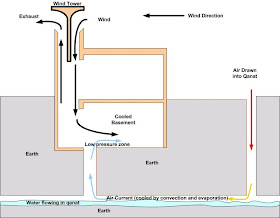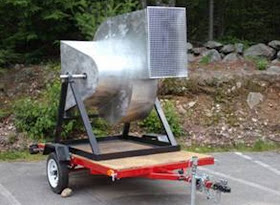How does this "innovative" bladeless wind technology beat 2,000 year old WindCatcher tech???

"bladeless concepts could be a game changer in the next few years." "Turbine-free wind power" was placed on the NY Times Magazine's annual Year in Ideas list with this video explaining the idea of a panel with several foam pads and piezoelectric connectors that harvest energy. The panels wouldn't make much noise and could be installed on facades, roofs, and almost anywhere else. They could also generate energy at a low cost and lower wind speed ...press release.
Haase: While the utilization of Piezoelectric energy harvesting has some great applications.... this is not one of them.
It is important to note that there are 100's of more viable ways to harvest wind power without the excess engineering materials and energy loss.
HTML clipboard
And bladeless wind in not innovative or a new concept.
 Bladeless Wind so 1900's - A wind turbine that uses boundary layers instead of blades to generate power has been patented by Solar Aero, a New Hampshire based not-for-profit scientific research organization. Modeled on the 1913 Tesla steam turbine, the Fuller turbine is virtually silent and completely enclosed, which avoids many of the drawbacks of bladed turbines such as noise, radar interference, visual pollution and wildlife injuries...the turbine then provides considerable torque to accelerate the rotation of the central driveshaft, which is directly coupled to an alternator, typically located at the base of a tower, or alternatively co-located on a rooftop."
Bladeless Wind so 1900's - A wind turbine that uses boundary layers instead of blades to generate power has been patented by Solar Aero, a New Hampshire based not-for-profit scientific research organization. Modeled on the 1913 Tesla steam turbine, the Fuller turbine is virtually silent and completely enclosed, which avoids many of the drawbacks of bladed turbines such as noise, radar interference, visual pollution and wildlife injuries...the turbine then provides considerable torque to accelerate the rotation of the central driveshaft, which is directly coupled to an alternator, typically located at the base of a tower, or alternatively co-located on a rooftop."But my favorite was inspired by ancient Persia
A new wind-power machine has been inspired by a centuries-old idea: Persian "wind catchers."

Windation Energy Systems, wind appliance that looks more or less like the modern heating and cooling equipment you see on flat corporate building rooftops.
There's a 8-by-8-foot frame around a 10-foot-high cylinder. Wind blows in the top and is directed to the bottom where the wind turns a turbine to make up to 5 kilowatts of electricity. A single unit wouldn't generate enough power for an entire office building but could offset a significant portion, the company says.
Windation CEO and founder, Mark Sheikhrezai, who is originally from Iran, said he was inspired by ancient Persian buildings that use air currents and reservoirs of water to cool buildings. Using differences in air pressure, these wind catcher buildings create a steady flow of air without any mechanical devices. Although Windation's wind appliance does draw air from the top like these buildings, Sheikhrezai said he used his expertise in centrifuges and rotors to manipulate the movement of the wind to generate electricity...the biggest advantages of Windation's appliance is its shape and ease of installation. Since all moving parts are contained,
Haase - I would suggest students and "innovators" read up on the major source of U.S. building energy costs (heating & cooling) and then apply the most basic, realistic and cost affective approachs to lower those costs. (passive heating & cooling). Then utilize the most modern controls to gain the most efficient from them...
And prove that just simple 100 or 2,000 year old ideas could reduce U.S. building energy costs by 10%... without the danger to birds, bats or people.